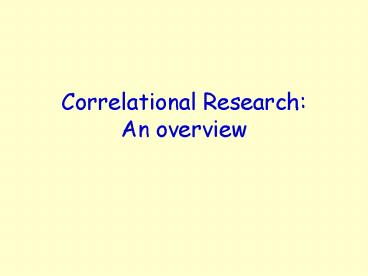Correlational Research: An overview - PowerPoint PPT Presentation
1 / 14
Title:
Correlational Research: An overview
Description:
... and GPA indicates that higher GPSs are associated with lower hours watching TV. Question: Does this mean that more hours spent watching TV leads to lower GPSs? ... – PowerPoint PPT presentation
Number of Views:75
Avg rating:3.0/5.0
Title: Correlational Research: An overview
1
Correlational Research An overview
2
Definition and Purpose
- Correlational research involves the collection of
data to determine the extent to which two (or
more) variables are related. - If a relationship exists, we say that the two
variables covary in some non-random way. - The strength of the relationship is expressed as
a correlation coefficient, r.
3
Purpose of Correlation Research
- Descriptive Show (or describe) the associations
among variables. - Hypothesis testing Test whether variables
expected to be related are, in fact, related. - Theory driven.
- Correlations often occur spuriously.
- Should not examine correlations, first, and then
construct a theory to explain them.
4
The Correlation Coefficient, r
- The coefficient, r, better known as the Pearson
product moment coefficient, gives a quantitative
measure of the linear relationship between two
variables, X and Y, say. - To indicate which variables are being correlated,
we sometimes write rXY. - An r of -1 (or close to -1) indicates a strong
negative or inverse relationship. - An r of 1 (or close to 1) indicates a strong
positive (or direct) relationship. - An r of 0 (or close to 0) indicates a lack (or at
least a weak) relationship.
5
A Table of Correlations
- Correlations among several variables are usually
given in a correlation table.
6
A Table of Correlations
- Only one half of a correlation table need be
displayed. The upper triangular half or
7
A Table of Correlations
- The lower triangular half.
8
A Table of Correlations
- Often the diagonal is replaced by dashes.
9
Correlation ? Causation
- The more highly correlated (i.e. the closer r is
to or 1) the more accurate are predictions
based on the relationship. - This, however, does not necessarily imply that
one variables is the cause of the other. - Implying causation from correlation is what
causal comparative research is all about.
10
Correlational Research Design
- Collect data on two or more variables for each
participant in the research study. - Minimally accepted sample size is 30.
- If the measures have low reliability, larger
sample sizes are needed. - If participants are to be subdivided (say, into
males and females) larges sample sizes are needed.
11
Sample Sizes
- Depends on the reliability of the measures.
- With reasonable reliability a minimum of 30 cases
with bivariate measures is usually acceptable. - The statistical test is a t test of the null
hypothesis H0 ?xy 0.0
12
Interpreting Correlations
- Correlations close to -1 or to 1 indicate the
same high degree of relationship, but in
different directions. - E.g., an r of -.87 between hours of TV watched
and GPA indicates that higher GPSs are associated
with lower hours watching TV. - Question Does this mean that more hours spent
watching TV leads to lower GPSs?
13
Interpreting Correlations
- Correlations lower than .5 typically are not very
interpretable. - Correlations in the 60s and 70s are considered
adequate for interpreting relationships among
variables within groups. - Correlations in the 80s and higher are good for
interpreting relationships among variables for
individuals. - In the end, however, the interpretability of a
correlation coefficient depends upon the purpose
of the study.
14
The END































